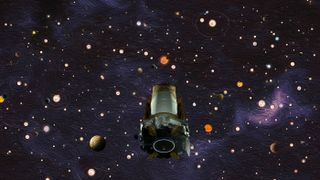In Search for Alien Planets, a New Era Will Rise from Kepler's Demise
The Kepler mission officially ended on Oct. 30, when NASA announced that the spacecraft had run out of fuel and would receive its last commands this week or next — but its legacy will stretch far beyond just the planets it happened to spot.
That's thanks to two trailblazing aspects of the mission, MIT astronomer Sara Seager told Space.com — the way it shattered our expectations about what other solar systems would look like, and the way it built up the scientific infrastructure around identifying planets.
"Kepler was just a game-changer, it was so pioneering for exoplanets," Seager said. "Before Kepler launched we only knew of hundreds of exoplanets and Kepler found thousands of them. And it found all sorts of crazy planets." [7 Greatest Alien Planet Discoveries by NASA's Kepler Spacecraft]

Those include plenty of planets that have no equivalent here in our familiar solar system — planets that orbit their star in less than one terrestrial day, planets that may be so hot that their surfaces are liquid lava, solar systems with a half dozen planets crammed in the equivalent of the space between our sun and Mercury's orbit.
"It found just so many crazy things we completely didn't expect," Seager said. That's true on a statistical level as well, she added — for example, planets two or three times the size of Earth are 10 times more common in Kepler's findings than planets like Jupiter are. "We don't even know what those planets are made of, we have no solar system counterpart," Seager said.
Seager is the deputy director of science for Kepler's successor, NASA's Transiting Exoplanet Survey Satellite (TESS), which launched in April and began science observations in July. Unlike in the early days of Kepler, scientists know exactly what to do with the data that TESS sends home every two weeks — even graduate students can build up the data-handling procedures they need to confidently identify planet candidates now, Seager said.
"Finding planets with the transit method has just become quite standard," she said. "TESS didn't have to solve those big problems." Kepler's leg up to TESS is paying off: Scientists have already announced two possible planets they've spotted in TESS data.
Get the Space.com Newsletter
Breaking space news, the latest updates on rocket launches, skywatching events and more!
But the next steps may not go as smoothly as the Kepler-TESS transition of dedicated exoplanet missions, Seager worries. The crucial James Webb Space Telescope, which will allow astronomers to study the atmospheres of exoplanets, has been much delayed, with launch now scheduled for 2021 — the year after the TESS primary mission wraps up.
That project's budget and timeline issues may hinder the next project on scientists' list, the Wide-Field Infrared Survey Telescope (WFIRST). WFIRST is scheduled to carry a technology demonstration of a coronagraph, which will let astronomers blot out stars and study the disks around them. [7 Ways to Find Alien Planets]
WFIRST's coronagraph instrument was demoted to a technology demonstration to cut costs. "It's not going to revolutionize science, but it will show that it works," Seager said. That will bolster the case for flying a full-service coronagraph on a future mission.
But for Seager, the Webb cost overruns should teach astronomers a valuable lesson for mission planning moving forward — trying to design one project that incorporates everyone's priorities is a recipe for a mission that spirals out of control.
"We did all the easy, cheaper things, now we want to do the harder things but if you want to do lots of hard things and put those all together you're just going to get into trouble," Seager said. "That shared thing now is so complicated and so mammoth and way too crazy."
Email Meghan Bartels at mbartels@space.com or follow her @meghanbartels. Follow us @Spacedotcom and Facebook. Original article on Space.com.
Join our Space Forums to keep talking space on the latest missions, night sky and more! And if you have a news tip, correction or comment, let us know at: community@space.com.

Meghan is a senior writer at Space.com and has more than five years' experience as a science journalist based in New York City. She joined Space.com in July 2018, with previous writing published in outlets including Newsweek and Audubon. Meghan earned an MA in science journalism from New York University and a BA in classics from Georgetown University, and in her free time she enjoys reading and visiting museums. Follow her on Twitter at @meghanbartels.











